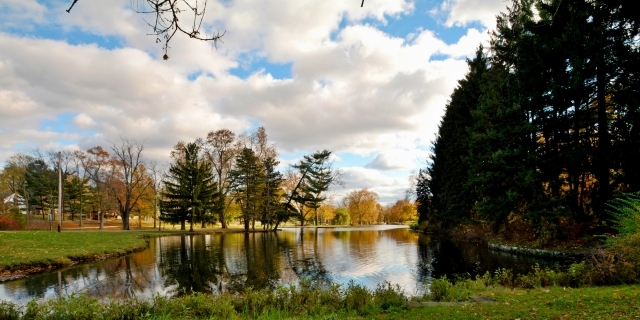Photographers! How do you handle dramatic light differences?

I shoot a lot of nature / landscape scenes where you have a bright sky, even on cloudy days, compared to a relatively dark target and often one gets blown out
i sometimes use in camera hdr but Nikon, for whatever reason, makes you revert to jpg to do so which can be a hassle, well not a hassle (I'm showing my lazy side lol )
any tips on how to get both light and dark targets without one getting blown out?
for exmaple: the attached pic, i handled as well as i could, but i would have liked the trees on the far right to be a bit brighter. Outside of using software or hdr, any tips?
There really are no tips for such a thing. A camera has a limited dynamic range of exposure latitude. Some day perhaps a camera will be able to "see" as our eyes do, but that is just not the case now. TRUE HDR is certainly a technique to deal with this, (camera on tripod, several different exposures, combine in software), but that is just not always practical to do.
Your best bet is to expose for the bright area (the sky), shoot is RAW, then bring up the shadow levels in your RAW processor program. If some noise appears in the adjusted shadows, then noise reduction can be very effective at taking it out.
Don't overlook using software with a RAW file to get the image you want. It is NOT "cheating". It is simply using modern technology to an advantage. If you are not going to use software, (the modern version of the darkroom), then you are not utilizing the tools you have at hand.
Agree with deep blue2 - also, make sure you expose to the right. That is to say that your histogram should be near the left side of the graph without being clipped. Also, you LCD displays a JPEG, so if you've got the blinkies set to show clipped highlights, you could still have detail in your RAW images.
If you use HDR techniques, shoot in raw and do the HDR processing on your computer. Convert your raw images to 16-bit/color TIFF. Photoshop's HDR function work quite well. I'm partial to Hugin which is a free panorama stitcher. Hugin can also do HDR processing. When shooting HDR, control the shutter speed only, keeping focus and aperture fixed.
Couple of methods;
- use graduated neutral density filters to balance the sky/foreground exposure
- bracket your exposures fofr highlights and shadows and then either use HDR software or exposure blending.
I would also recommend that when you meter on the sky, you drop the exposure by up to a stop, as the light meter meters for a mid-tone, and your want richer colours in the sky.
The last time I checked, optical filters were still a very viable method of correction for situations similar to the one described.
Take a picture and meter for the sky, take another picture and meter for the subject, and then merge them.
What I do is
Set it on a tripod and take multiple photos with different exposure and then I combine images in photoshop for the perfect sky, perfect shadows and perfect tones

Rather than HDR, which I'm not keen on at all - although I used to experiment with HDR quite a lot - I actually prefer simpler techniques such as exposure blending. It doesn't look so fake. I shoot RAW, and take two exposures, and blend them using image editing software.
Often shooting a single RAW image is enough, because there are ways to recover highlights and shadows in RAW processing that just can't be done with jpegs.
